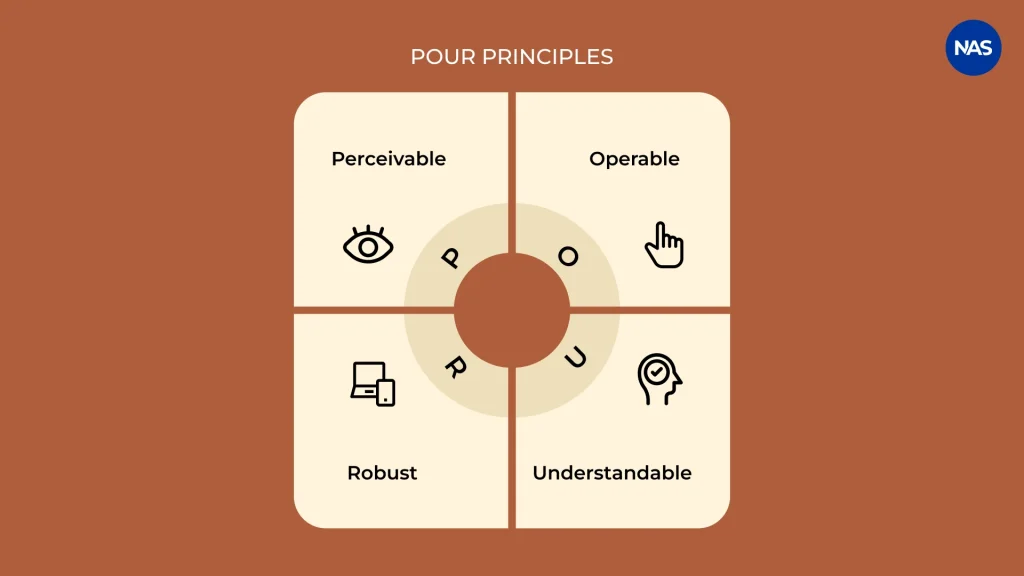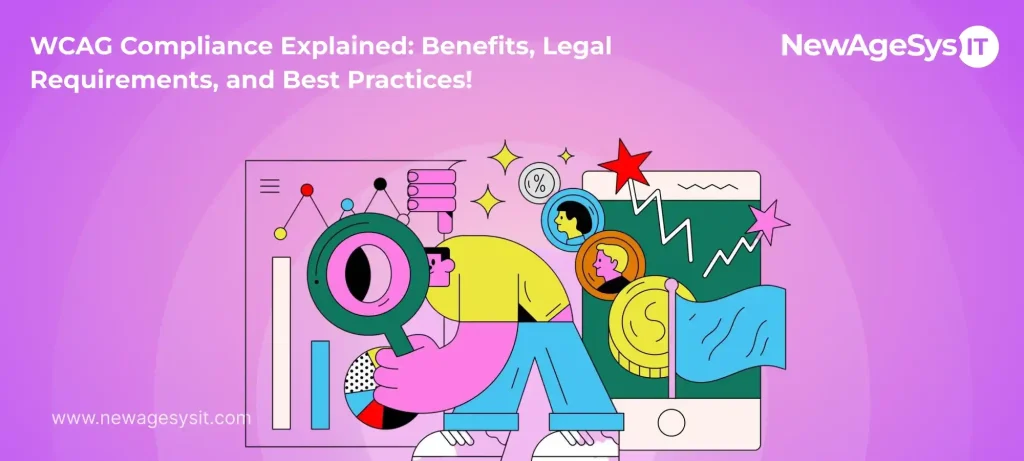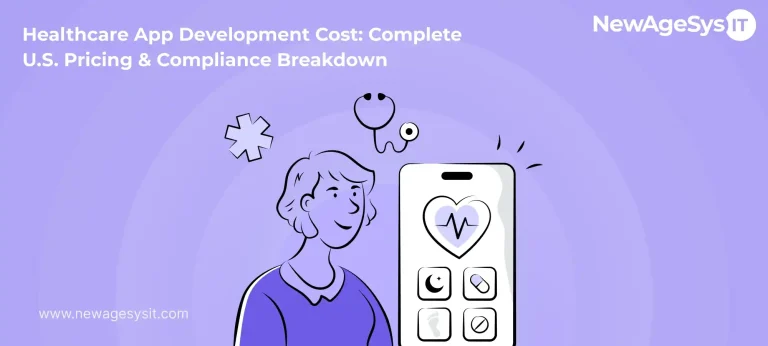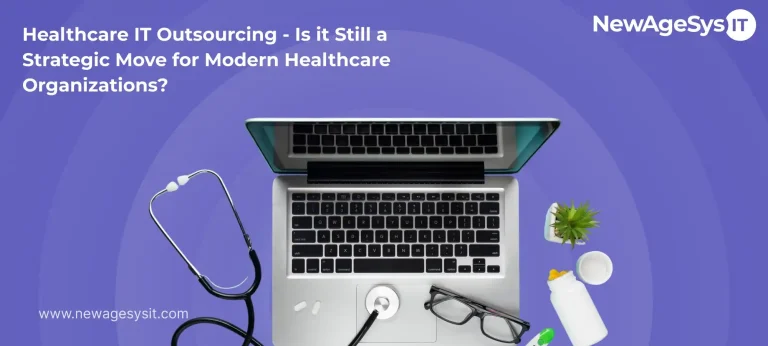| Key Takeaways: WCAG compliance makes sure that you are legally protected by global accessibility laws of different nations. Accessible digital solutions market expands to 1.3 billion people across the people with disabilities, as suggested by WHO. Continuous audits, testing, and updates are a vital part of lasting accessibility. Partnering with experts like NewAgeSys with proven experience will not only be cost-effective but will also streamline compliance related work. |
Who needs more people to at least check out their business or the services offered through it? Well, any company trying to stay or wanting to become profitable across the globe. But, that also means making things accessible for as many people across the globe as possible, ain’t that true?
WCAG compliance as a guideline ensures that the aforementioned happens. As of now, it is not a legal mandate for all nations globally. However, there are tons of very important countries from a business perspective, like the U.S.A., Canada, the European Union, India, Australia, etc., that have adopted it, making it legally enforceable.
So, if you are someone caught up in the headache of following WCAG guidelines, the article is for you. We have used up our experience of 25+ years to give you a balanced perspective, explaining what it is, why to do it, how to integrate it, and other nuances.
So, first, let’s understand WCAG compliance to understand the ‘Why’ of it with context.
What is WCAG Compliance? – Nitty Gritties of the Compliance
WCAG stands for Web Content Accessibility Guidelines.
If we talk about its definition, its official definition as per W3C (World Wide Web Consortium):
“The Web Content Accessibility Guidelines (WCAG) are developed through the W3C process in cooperation with individuals and organizations around the world, with a goal of providing a single shared standard for web content accessibility that meets the needs of individuals, organizations, and governments internationally.”
WCAG guidelines are applied to all your digital platforms, such as websites, mobile applications, and online documents. The core aim of WCAG standards is to create a global benchmark to make digital content accessible to everyone, which includes people with visual, auditory, motor, or cognitive disabilities.
At its core, the compliance aims to make your digital presence available for all users:

- Perceivable
- Operable
- Understandable
- Interactable
These guidelines not only help you make your content more inclusive but also improve its usability for any user coming to visit your website.
If we discuss its history, then the guidelines were developed by W3C’s Web Accessibility Initiative (WAI). In fact, if you had the question ‘Who creates the web content accessibility guidelines?’, this is the body that creates and updates the guidelines that are used worldwide.
And, as discussed earlier, WCAG compliance regulations are not a de facto mandate, but several countries have considered its merits and made it legally enforceable.
Now, if you are interested in geeking out a bit more about its history, then here’s a table.
📌 Evolution of Current WCAG Standards
| Version | Year Released | Focus Areas | Key WCAG Requirements Added |
|---|---|---|---|
| WCAG 2.0 | 2008 | Foundation for accessibility | Defined levels A, AA, AAA |
| WCAG 2.1 | 2018 | Mobile accessibility, low vision, and cognitive needs | 17 new success criteria (e.g., reflow, contrast, gestures) |
| WCAG 2.2 | 2023 | Cognitive and learning disabilities, improved mobile UX | 9 new success criteria (e.g., accessible authentication, focus not obscured) |
Why WCAG Implementation Matters?
As discussed earlier, WCAG compliance explicitly demands businesses to make their digital content accessible, even for people with special abilities.
So, it is important to factor in what we are losing in terms of numbers if we somehow get beyond without implementing the WCAG standards.
| Disability Category | Approximate Global Population (2025) |
|---|---|
| Visual (blindness, low vision) | 2.2 billion |
| Auditory (deafness or with some hearing issue) | 2.5 billion (hearing impairment) |
| Speech (speech disabilities) | 170 million (report from 2021) |
| Cognitive (learning, intellectual) | 15% of worldwide students |
| Neurodiverse (autism, dyslexia, etc.) | 15-20% of the global population |
| Multiple Disabilities/Combinations | 16% of the worldwide population |
In fact, a total population of 1.3 billion (last updated in 2023) has some form of disability, as per the WHO (World Health Organization), which is close to the country with the highest population. Basically, if you are trying to avoid WCAG compliance, this number of people won’t be able to access your services effectively.
Beyond that, a B2B conglomerate may argue, the number is great, but it is only significant for a B2C business. Most people in the business realm won’t comprehend with the earlier statement, but for the sake of a hypothetical argument, here is a list of notable leaders with disabilities:
- Diego Mariscal (Cerebral Palsy; Founder, CEO, and Chief Disabled Officer of 2Gether-International (2GI))
- Martyn Sibley (Spinal Muscular Atrophy (SMA); Serial founder (Disability Horizons, Accomable) and disability inclusion advocate)
- Collette Divitto (Down Syndrome; Founder of Collettey’s (cookie business))
- John Cronin (Down Syndrome; Co-founder and Chief Happiness Officer of John’s Crazy Socks)
- Alvaro Silberstein (Paraplegia (Chest down); Co-founder of Wheel the World)
- Shahar Botzer (Muscular Dystrophy; Venture capitalist; co-founder of Good Company (VC fund))
Now, if there are leaders with physical disabilities who are not just a part of leading brands but have been founders, imagine the number of influential people with disabilities in businesses who directly affect your B2B business.
Further on, on a lighter note, these are some other reasons as to why you should think of becoming WCAG compliant:
- It ensures equal access to digital services for everyone.
- It aligns your platform with international WCAG standards
- It reduces legal risks by meeting accessibility regulations.
- It improves the overall SEO and user experience of your services across devices.
WCAG Guidelines and Levels of Compliance
We’ve already talked about WCAG guidelines in some capacity. However, for a much clearer understanding and to make the surrounding nuances more detailed, the section is created.
As discussed earlier, WCAG compliance rules are made up of four fundamental principles. These are often referred to as POUR. Any new WCAG compliance policy falls under one of these four principles. Together, these principles are the flag bearers of any change that is defined for digital content universally.
Let’s discuss them:
🔑 The Four Core Principles (POUR)
| Principle | Meaning | Example (WCAG Requirements) |
|---|---|---|
| Perceivable | Information and UI must be presented in ways users can perceive. | Provide text alternatives for images; captions for videos; sufficient color contrast. |
| Operable | Users must be able to operate interface components. | Ensure keyboard navigation works; avoid time limits; allow pause/stop of auto-play content. |
| Understandable | Information and interface must be easy to understand. | Use simple language; consistent navigation; avoid confusing instructions. |
| Robust | Content must be reliable across different devices and assistive technologies. | Ensure compatibility with screen readers and evolving browsers. |
The combination of these four principles ensures that your content is usable by everyone, regardless of any disability.
🎯 WCAG Standards Levels
WCAG standards require three levels of conformance. This is based on the number of rules followed by any organization in accordance with WCAG implementation.
| Level | Description | Examples of Compliance Rules |
|---|---|---|
| Level A (Basic) | Minimum level: addresses the most critical barriers. | Alt text for images, keyboard accessibility, and captions for audio. |
| Level AA (Industry Norm) | Mid-level; most widely adopted and legally required in many countries. | Contrast ratio of at least 4.5:1; resizable text; error identification. |
| Level AAA (Advanced) | Highest level; not always required, but ideal for inclusivity. | Contrast ratio of at least 7:1; sign language interpretation; extended audio descriptions. |
It is important to know that WCAG AA is considered the industry norm. Why? Well, it balances inclusivity with practical feasibility. Also, it has been established as a benchmark in most accessibility regulations around the world.
📏 WCAG Compliance Rules: Contrast Example
One of the most important WCAG compliance rules is color contrast.
| Requirement (Mandatory) | Recommendation (Good Practice) |
|---|---|
| Text must have a contrast ratio of at least 4.5:1 (Level AA) | Use a 7:1 contrast ratio for optimal readability (Level AAA). |
| Large text (over 18pt) must have at least 3:1 contrast | Ensure all design elements (icons, charts, buttons) also meet contrast standards. |
WCAG Requirements for Businesses
After so much exposition, it is finally time for us to tell you about the WCAG requirements you need to fulfill as a business to make your digital content accessible. Again, reiterating that these requirements cover websites, applications, and documents.
📌 Core WCAG Requirements
| Requirement | What It Means | Example in Practice |
|---|---|---|
| Text Alternatives | Non-text content must have a text equivalent. | Alt text for product images in e-commerce. |
| Keyboard Accessibility | All functions should be operable by keyboard. | Users can navigate a banking app without a mouse. |
| Color Contrast | Text and visuals must meet contrast ratios. | Finance dashboards with clear, high-contrast text. |
| Captions & Audio Descriptions | Multimedia must be accessible to deaf or blind users. | Subtitles for training videos in healthcare apps. |
| Predictable Navigation | Interfaces must be consistent and predictable. | Government portals with uniform menu layouts. |
🌍 Application of WCAG Compliance Across Industries
Accessibility is not industry-specific — WCAG compliance regulations apply across all sectors.
WCAG compliance regulations are at play, anywhere digital content is produced. So, for further context, here are a few industries and applications of WCAG compliance + benefits.
| Industry | Application of WCAG Compliance | Benefit of WCAG Compliance |
|---|---|---|
| Finance | Online banking portals and investment apps must be accessible. | Builds customer trust, avoids lawsuits, and ensures equal access. |
| Healthcare | Patient portals, telemedicine apps, EHR systems. | Protects patient rights, HIPAA alignment, and better patient care. |
| E-commerce | Online stores, checkout flows, shopping apps. | Increases sales, reduces cart abandonment, and expands audience. |
| Government | Public portals, citizen services, online forms. | Meets legal mandates, ensures inclusivity, and reduces the digital divide. |
💻 WCAG Compliance for IT Industry / IT Sector
Know this: if you are an IT company, WCAG compliance policy isn’t optional. We’ve worked with tonnes of companies who may have had this misconception that they can avoid WCAG compliance.
However, it is almost a mandate, especially for certain countries, to embed these guidelines into every software, app, and website solution in the design stage itself.
| Area | WCAG Application |
|---|---|
| Software Development | UI/UX must meet POUR principles; ensure screen reader compatibility. |
| Web Development | Websites must follow WCAG Standards AA, especially for navigation, forms, and media. |
| Mobile Applications | Gesture alternatives, responsive layouts, and accessible authentication. |
| Enterprise IT Systems | Dashboards, intranets, and SaaS solutions must be accessible for employees with disabilities. |
WCAG Compliance Regulations and Policies
Till now, we have only extrapolated on what the WCAG requirements want from a business. However, as said earlier, it is not a law. But, it is something that is adopted by nations that, in most cases, means the same but may differ in names, their relevance, and even the impact on business.
So, below we have listed out popular laws tied to WCAG, as set up by different nations, in their area of jurisdiction:
| Region / Country | Law / Regulation | WCAG Relevance | Impact on Businesses |
|---|---|---|---|
| USA | ADA (Americans with Disabilities Act) | Courts interpret the ADA to apply to digital platforms. | Non-compliance may result in lawsuits and settlement costs. |
| USA | Section 508 (Rehabilitation Act) | Federal agencies and vendors must meet WCAG-based standards. | Mandatory for government contracts and digital tools. |
| European Union | EU Web Accessibility Directive | Public sector websites & apps must follow WCAG 2.1. | Expands to private services offering “essential” digital access. |
| India | Rights of Persons with Disabilities (RPwD) Act, 2016 | Requires equal access to digital resources for persons with disabilities. | Websites/apps must be WCAG-compliant to avoid penalties. |
Why Do Businesses Need a WCAG Compliance Policy?
There are a few reasons why a company would like to implement the current WCAG standards, such as:
- Legal Protection: Reduces risk of lawsuits and penalties.
- Reputation: Shows inclusivity and corporate responsibility.
- Market Reach: Makes digital products accessible to millions of new users.
- Future Proofing: Prepares your business for stricter regulations as digital accessibility awareness grows.
Below, we have mentioned a few cases where the inability to effectively implement WCAG led to consequences for different businesses.
Case References (Brief)
| Case | Details | Outcome |
|---|---|---|
| Robles v. Domino’s (USA) | Blind plaintiffs could not order food via Domino’s website/app. | Court upheld ADA applicability → Domino’s liable. |
| National Federation of the Blind v. Target (USA) | Target’s website is inaccessible to visually impaired users. | Target settled for $6 million + compliance monitoring. |
| Harvard & MIT Lawsuits (USA) | Lack of captions in online educational videos. | Required to add captions and improve accessibility. |
Benefits of WCAG Compliance for Business
Direct or indirect, we have outlined several benefits in this article before. However, to put the final nail in the coffin and for ease, we have created this section that lists all the primary benefits you can enjoy by becoming compliant.
- Reduced Legal Risk – Adherence helps avoid costly lawsuits, penalties, and compliance issues.
- Wider Customer Reach – It makes your products/services accessible to people with disabilities, expanding market size.
- Improved User Experience (UX) – Accessibility improvements, like clear navigation, captions, alt text, etc., benefit all users and not just those with disabilities.
- SEO Advantages – Content gets indexed better on search engines, thereby leading to improved rankings on SERP (search engine result pages).
- Brand Reputation & Trust – It demonstrates inclusivity, social responsibility, and ethical leadership.
- Higher Customer Loyalty – An inclusive platform encourages repeat users and positive word-of-mouth.
- Future-Proofing – For any anticipated evolving legal requirements and accessibility standards, your business is pre-prepared.
- Innovation Driver – It forces businesses to adopt cleaner, more user-friendly designs and technology.
- Better Performance & Usability – Accessible sites tend to load faster, offering clearer structures while reducing bounce rates.
- Competitive Advantage – Compliance can differentiate a brand in industries where accessibility is often overlooked.
How to be WCAG Compliance Ready?
Becoming WCAG-compliant is a structured process, which is divided into four essential steps. So, let’s check them out:
Note: These steps act as a segue to become WCAG compliant; they are not an exact blueprint that, for instance, we might take as an outsourcing company to make you compliant.
1. Audit
Start by assessing your current website or application against the latest WCAG requirements. For this, you can manually do the task (which will be time-consuming) or use automated tools like AXE, WAVE, etc. However, the combination of manual checks with these tools will help a lot more in figuring out the existing gaps based on severity and user impact.
2. Implement
Make use of accessibility WCAG best practices while designing and coding your product. This, in most cases, would entail ensuring proper color contrast, alt text, captions, ARIA labels, and keyboard navigation.
For an outsourcing company, this is self-explanatory. However, with your in-house teams, make sure they are well-trained to adopt these practices in their workflow.
3. Test
Run manual testing using assistive technologies such as screen readers, voice controls, etc. And, by the side, conduct automated testing too to quickly catch recurring issues.
A good way to get some real feedback in this aspect would be to include people with disabilities for a much clearer real-world validation.
4. Maintain
Keep your accessibility policies updated as per the current WCAG norms. Re-audit your services for any major updates or releases. And, continuously monitor for any regulatory changes to remain legally compliant.
Why Partner with NewAgeSys for WCAG Compliance?
Well, as mentioned earlier, we bring in extensive experience of more than 25+ years of working, providing software solutions to clients. To add, we’ve had clients from multiple industries throughout the years we have been operational.
It is because of this experience that we are well-versed with the ropes around WCAG implementation. In fact, our knowledge doesn’t extend to regions like the U.S.; rather, we provide global. And, if we have to sum up the benefits we can deliver to you, here is a list:
- 25+ years of IT outsourcing excellence in industries such as healthcare, fintech, transportation, education, SaaS, etc.
- Proven capabilities in building websites, mobile apps, and enterprise solutions that follow accessibility.
- We have delivered IT solutions that align with WCAG, ADA, Section 508, and other global accessibility regulations.
- We offer end-to-end services that cover the entire lifecycle of accessibility compliance, which includes: Accessibility Audits, Design & Development Implementation, Testing, and Continuous Monitoring & Updates.
Conclusion
A lot of businesses often tend to get into areas where they would market their product to almost every individual on Mother Earth. Their messaging, their branding, and their offerings would shriek as high as possible, exclaiming, ‘Use us’. But any good marketer, or any good leader, would tell you ‘bad move.’ And, not to digress too deeply, but these same businesses might abstain from utilizing the power of WCAG compliance, which actually increases the sample size of your target audience.
Whether it is legally enforceable or not, purely from a business standpoint, WCAG compliance can help your business. It is a segue for people who may be willing to become your loyal customer, and all you have to do is make your service and the idea behind it accessible to them.
And, if by any means you are looking for capable partners, we are just a mail or a call away (Whichever you prefer). We are based in the U.S.A., However, thanks to our offshore development center, we are able to sustain an attractive pricing while retaining the work ethic of the U.S.. So, if things are smooth, we’ll be looking forward to hearing from you.
FAQs:
Q.1 What are the 17 success criteria of WCAG 2.1?
To become compliant as per WCAG 2.1, there were 17 new success criteria added on top of the previous WCAG 2.0. Each of these criteria is divided into three levels, so let’s check them out:
🔹 Level A (5 new criteria)
- Orientation
- Character Key Shortcuts
- Pointer Gestures
- Pointer Cancellation
- Label in Name
🔹 Level AA (7 new criteria)
- Identify Input Purpose
- Reflow
- Non-Text Contrast
- Text Spacing
- Content on Hover or Focus
- Motion Actuation
- Status Messages
🔹 Level AAA (5 new criteria)
- Identify Purpose
- Timeouts
- Animation from Interactions
- Target Size
- Concurrent Input Mechanisms
Q.2 What are the nine new success criteria of WCAG 2.2?
WCAG 2.2 added nine new success criteria, divided between levels. Those are:
🔹 Level A (2 new criteria)
- Focus Not Obscured
- Dragging Movements
🔹 Level AA (4 new criteria)
- Focus Not Obscured (Enhanced)
- Focus Appearance
- Target Size (Minimum)
- Consistent Help
🔹 Level AAA (3 new criteria)
- Focus Appearance (Enhanced)
- Dragging Movements (Enhanced)
- Accessible Authentication (Enhanced)
Q.3 Define the different levels of WCAG 2.0?
Not just WCAG 2.0, but any update on WCAG norms is basically divided into three different levels, which are:
- Level A (Basic) – Minimum requirements that remove the most critical barriers. For example, Alt text for images, keyboard navigation, etc.
- Level AA (Standard) – Industry norms, and in most cases, are legally required in many countries. Examples include 4:5:1 color contrast, resizable text, error identification, etc.
- Level AAA (Advanced) – Highest accessibility and is rarely required. However, it is great for inclusivity. Examples are 7:1 contrast, sign language for audio, extended audio descriptions, etc.
Q.4 What are the POUR principles in WCAG?
The POUR principles in WCAG are:
- Perceivable – The content should be presented in ways that make it perceivable by users.
- Operable – Interface must be usable with different inputs.
- Understandable – Content and UI need to be clear and predictable.
- Robust – Content should work across the current and future technologies.
Q.5 Which industries are most impacted by WCAG compliance?
These are the top 5 industries that are affected the most by WCAG compliance:
- Healthcare
- Finance & Banking
- Education
- Retail & eCommerce
- Government & Public Sector
Q.6 What global laws are tied to WCAG compliance?
Here are some global laws tied to WCAG compliance:
United States:
- ADA (Americans with Disabilities Act)
- Section 508 (Rehabilitation Act)
European Union:
- EN 301 549 Standard
- European Accessibility Act (EAA)
Canada:
- Accessible Canada Act (ACA)
- AODA (Ontario)
United Kingdom:
Equality Act 2010 & Public Sector Accessibility Regulation 2018
Australia:
Disability Discrimination Act (DDA)
India:
RPwD Act (Rights of Persons with Disabilities, 2016)
Q.7 Why is WCAG AA considered the standard for most businesses?
WCAG Level AA is considered the most standard level that aligns with most businesses’ WCAG requirements because of several reasons, such as:
- Legal Compliance – Most global laws demand WCAG 2.0/2.1 AA, not A or AAA
- Balanced Approach – Covers critical accessibility needs without asking for the excruciatingly demanding AAA-level norms.
- User Reach – It removes major barriers for people with visual, hearing, motor, and cognitive disabilities.
- Industry Norm – WCAG AA is a worldwide recognized benchmark used for accessibility in websites, apps, and digital products.
Q.8 What are some tools that businesses can use to assess WCAG compliance?
There are many different categories of tools that are utilized for the assessment of WCAG compliance. For ease, we have mentioned those categories and popular tools.
1. Automated Testing Tools
- WAVE (Web Accessibility Evaluation Tool)
- axe DevTools
- Lighthouse (Google Chrome)
2. Comprehensive Platforms
- Deque WorldSpace / axe Monitor
- Level Access (formerly AMP)
- Monsido
3. Screen Readers for Manual Testing
- NVDA (Windows)
- JAWS (Windows)
- VoiceOver (Mac/iOS)
4. Color & Contrast Checkers
- Contrast Checker (by WebAIM)
- TPGi Colour Contrast Analyser
Q.9 Is WCAG compliance mandatory for private businesses?
Again, it’s not mandatory if it isn’t legally enforceable in your country. However, if your business is situated in nations like the USA, Canada, Australia, the UK, India, or the European Union, then yes. Why? Because each of these countries has laws that are based on WCAG compliance and therefore are legally enforceable on any private businesses.


























